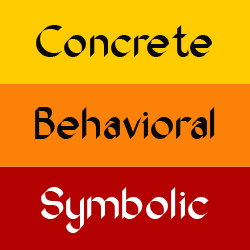 Educator Nitza Hidalgo (1993) has developed a model to help us look at culture and how the components of our individual cultures might be categorized.
Educator Nitza Hidalgo (1993) has developed a model to help us look at culture and how the components of our individual cultures might be categorized.
- Concrete (see): This level of culture is the most visible and tangible level of culture, and includes the most surface-level dimensions such as clothes, music, food, games, etc. These aspects of culture are often those which provide the focus for multicultural festivals or celebrations.
- Behavioral (act): This level of culture clarifies how we define our social roles, the language we speak, and our approaches to nonverbal communication. The behavioral level reflects our values. Aspects to be listed in this category include language, gender roles, family structure, political affiliation, and other items that situate us organizationally in society.
- Symbolic (think): This level of culture includes our values and beliefs. It can be abstract, but it is most often the key to how individuals define themselves. It includes values systems, customs, spirituality, religion, worldview, beliefs, and mores.
The Interactive Practice on the levels of culture gives you the opportunity to explore this model further. This interactivity requires Flash. Use the PDF version if you are unable to open the Flash activity or want to print the practice.
Content Integration
Now think about your past experience with multicultural education.
Teachers use several different approaches to integrate content about racial, ethnic, and cultural groups into the curriculum. One of the most popular is the Contributions Approach. When this approach is used, teachers insert isolated facts about ethnic and cultural group heroes and heroines into the curriculum without changing the structure of their lesson plans and units. Often when this approach is used, lessons about ethnic minorities are limited primarily to ethnic holidays and celebrations, such as Martin Luther King's Birthday and Cinco de Mayo. The major problem with this approach is that it reinforces the notion, already held by many students, that ethnic minorities are not integral parts of mainstream U.S. society and that African American history and Mexican American history are separate and apart from U.S. history.
The Additive Approach is also frequently used by teachers to integrate content about ethnic and cultural groups into the school curriculum. In this approach, the organization and structure of the curriculum remains unchanged. Special units on ethnic and cultural groups are added to the curriculum, such as units on African Americans in the West, Indian Removal, and the internment of the Japanese Americans. While an improvement over the Contributions Approach, the Additive Approach is problematic because ethnic and cultural groups remain on the margin of the mainstream curriculum. (Banks, n.d.) (Emphasis added)
Isolated facts, holidays, and celebrations, are all examples of the concrete level of culture. Focusing exclusively on the concrete level of culture in our curriculum can be problematic, even though it is often done with good intentions.
 Levels of Culture
Levels of Culture